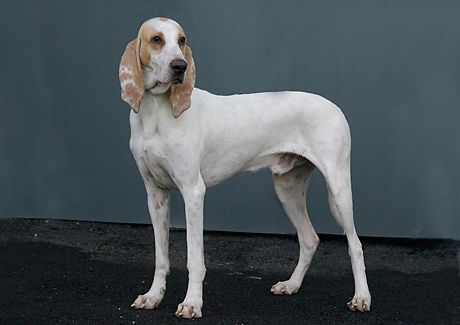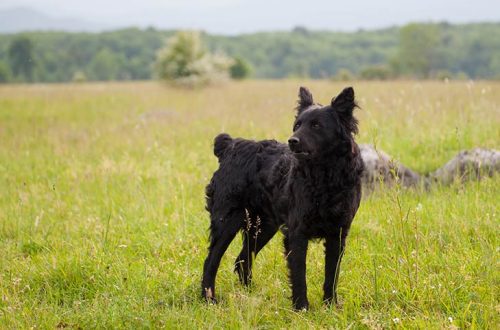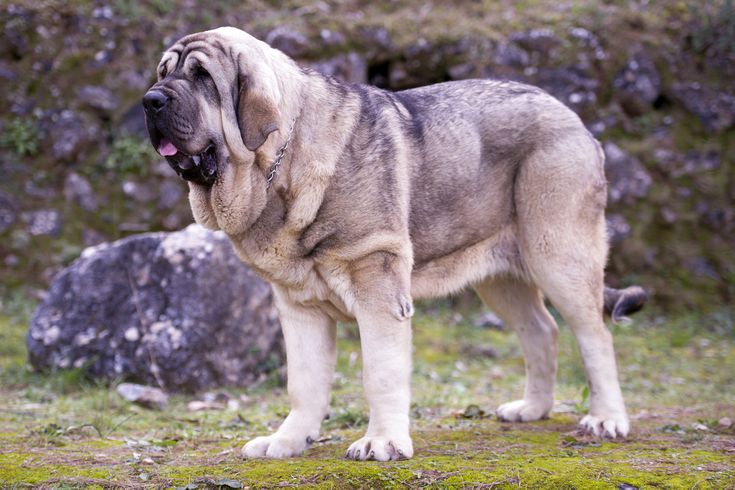
Spanish Mastiff
The Spanish Mastiff hides a good-natured character under the appearance of a gloomy giant and shows it only to close people. The dog will make not only an excellent watchman, but also a friend for many years. The main thing is to find an approach to the animal and enjoy its company!
Contents
- Characteristics of Spanish Mastiff
- Basic moments
- History of the Spanish Mastiff
- Character
- Appearance of the Spanish Mastiff
- The nature of the Spanish mastiff
- Education and training Spanish Mastiff
- Care and maintenance
- Health of the spanish mastiff
- How to choose a puppy
- How much is the spanish mastiff
- Spanish Mastiff – Video
Characteristics of Spanish Mastiff
| Country of origin | Spain |
| The size | large |
| Growth | 72–77 cm |
| Weight | from 50 kg |
| Age | 10–11 years old |
| FCI breed group | pinschers and schnauzers, molossians, mountain and swiss cattle dogs |
Basic moments
- The Spanish Mastiff needs a fair and responsible leader who will direct his potential in the right direction.
- A prerequisite for keeping is early socialization, otherwise the animal will grow up aggressive and unsociable.
- Representatives of the breed are phlegmatic and calm creatures: it is extremely difficult to get them out of balance.
- Mastiffs are tolerant of strangers and animals, but in the event of the slightest aggression they will show what they are capable of.
- These dogs do not compete for the territory and attention of the owner, so they get along with their relatives and cats without any problems.
- Spanish Molossians make excellent nannies for children: fun and active games are guaranteed!
- Hunting and watchdog instincts are the main cause of mastiffs’ anxiety at night.
- Representatives of the breed are very attached to the house, so they rarely run away from their territory.
- Spaniards are not a suitable breed for beginners.
History of the Spanish Mastiff
The past of the Spanish Molossians is rooted in transcendental antiquity. The first literary mention of the breed dates back to the second half of the 4th century BC. They became Virgil’s didactic poem “Georgics” – a colorful story about cattle breeding, agriculture and viticulture of that time.
There are versions that mastiffs appeared much earlier: long before the Roman invasion of the Iberian Peninsula. One theory connects dogs with Phoenician merchants, the other with nomads from Asia. “Spaniards” have an outward resemblance to Tibetan Mastiffs , Caucasian and Sharplanin Shepherd Dogs, which suggests that these breeds have a common ancestor.
The first Spanish mastiffs were more modest in size, but they were enough to protect livestock during transhumance. So representatives of the breed became hardworking shepherds. They were valued for their professional qualities – poise, courage and independence. The latter was extremely important, because at night the dogs were left without a master’s accompaniment and single-handedly played the role of a watchman.
If necessary, the “Spaniards” could protect the cattle from the attack of wild animals: wild boars, wolves and even bears. During the haul, the mastiffs led the herd for several days, doing well without food and not allowing themselves to attack their “wards”.
Basically, the Spanish breed was used for grazing sheep. The dog was assigned to a flock of one thousand heads. Mastiffs were subjected to strict selection, evaluating not only working qualities, but also external characteristics. First of all, cattle breeders paid attention to the size of the head and the depth of the body of the animal.
For a long time, the “Spaniards” played the role of purely working dogs and did not attract the attention of cynological organizations. The first registration of representatives of the breed took place at the beginning of the 20th century. A piebald male named Machaco, a participant in the International Dog Show in Madrid, became the lucky one. At the same time, active urbanization has caused a reduction in pastoralists and, as a result, the number of mastiffs. The civil war in Spain and the crisis that followed negatively affected the existence of the breed.
The breed was saved thanks to the shepherds, who continued to keep the sheep. It was they who provided the dogs for further selection. The first standard appeared in 1946 through the efforts of the breeder Luis del Portillo. He traveled extensively in the province of Leon in search of the largest specimens for breeding. After 20 years, another breeder, Amodel Alejandro, began to work on the development of the breed. His pets became the progenitors of the modern lines of the “Spaniards”: El Pinotar, Sacaries Pieto, Herminho Tascon and Manalo Martineda.
The final breed standard appeared in the 1970s, but the official recognition of the mastiff took place only in 1982. At the same time, the breeder Carlos Solas developed a new breeding program for dogs. To date, there are about 10 official nurseries where you can get a true friend of the Spanish Mastiff breed.
Character
The Spanish mastiffs have a very calm, balanced and even melancholy character, this dog demonstrates superiority over others with all its appearance. She is not familiar with aggression and the habit of attacking for no reason, so the pet deserves full trust. If the mastiff nevertheless gave a voice, it means that something really serious has happened, since restraint is another hallmark of the breed.
Thanks to a stable psyche, these animals live perfectly in families with children, including small ones, whom they will never offend, they will treat them reverently and attentively, perceiving them as a herd that needs to be protected.
In order for all positive character traits to be fully manifested, a lot of work needs to be done with the Spanish Mastiff, otherwise an ill-mannered dog can be a threat. Due to their high intelligence, these pets are easy to train , during which the owner often needs to show patience and perseverance, since the Spanish mastiffs are wayward and prefer to make decisions on their own. At the same time, rudeness and punishment should be avoided. The main thing is that the pet must feel the authority of the owner and understand who is in charge in the house.
Behaviour
The development of the Spanish Mastiff takes quite a long time. Both psychologically and physically, this process is completed by the age of three or four, so all this time you need to train and educate him.
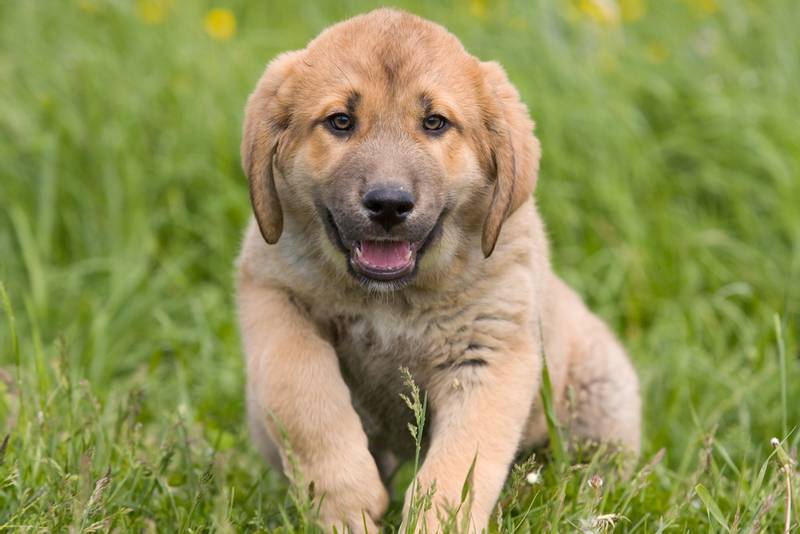

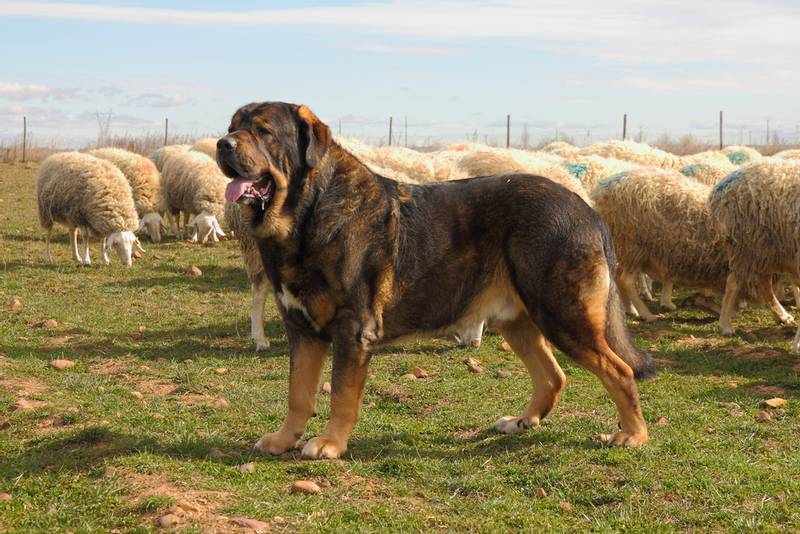

Appearance of the Spanish Mastiff
“Spaniards” refers to the Molossian breeds. Majestic and powerful animals in any situation retain their dignity. The Spanish mastiffs rightfully deserve the title of Hercules in the dog world!
The breed standard determines the height of animals: for males – from 77 cm, for females – from 72 cm. Sexual dimorphism can be traced: males look stronger and stronger than females. In addition, they are more attentive and observant. Body weight varies between 70-120 kg.
Head and skull
The mastiff’s head is strong and large, but in comparison with the body, its dimensions are harmonious. It has the shape of a truncated pyramid with a wide base, when viewed from above it looks square. The skull is strong and proportionate, with a convex profile. Its length corresponds to the width or slightly exceeds it. A bump is clearly visible on the back of the head.
Muzzle
The muzzle of the Spanish Mastiff is moderately broad. Its length is in the ratio of 2:3 to the length of the skull. It has a square shape, gradually tapering from the base to the tip. The forehead is flat; stop slightly sloping, but weakly expressed. The straight back of the nose is lowered, passing to the lobe with wide open nostrils. The upper lip hangs over the lower one, forming a wing. Small “pockets” can be seen in the corners of the mouth. The mucosa is exposed, pigmented black.
Ears
The ears of the dog are medium in size, flattened. They have the shape of a triangle with a rounded top. Set above the line of the outer corners of the eyes. Hanging, close to the cheeks. When the dog is alert, the tips of the ears are slightly lifted and lean forward.
Eyes
The mastiff’s eyes appear small in comparison to the size of the head. They are almond-shaped, oblique. Color – brown or hazel; the darker the better. The fleshy eyelids have a black edging. The lower eyelid droops, slightly exposing the conjunctiva. Although the look seems melancholy and calm, with closer contact with the dog, hardness and severity are noticeable.
Jaws and teeth
Strong and wide jaws form a scissor bite. A complete dental formula is required: medium-sized incisors, sharp canines, premolars and powerful molars. This arrangement of teeth provides a strong grip and retention of prey. This was used by the ancestors of mastiffs, protecting the herd from predators.
Neck
Powerful and strong, although rather short. Set on high and obliquely, the muscles are well developed. Elastic leather forms a double dewlap at the bottom.
Frame
The Spanish Mastiff is the owner of a rectangular and strong body. The withers are well marked. The back is long and muscular, keeping a horizontal position even in motion. It passes into a wide and slightly arched loin, and that into a 45° sloping croup. The height of the mastiff in this part of the body corresponds to its height at the withers. The abdomen and groin line are moderately tucked up.
Spanish Mastiff Tail
The tail has a medium set, tapering from a wide base to a tip. At rest, it hangs down to the hocks, during movement it rises in the manner of a saber, but is not thrown over the back or croup.
Forelimbs
Set straight and parallel to each other. Strong bones and developed muscles are noticeable. The long arms are set at an angle of 100° to the ground. The elbows, tightly pressed to the sides of the “Spaniard”, are directed back. The forearms are sheer, forming an angle of 125 ° with the elbows. Their length should be three times the length of the pasterns. Massive wrist joints pass into slightly inclined and strong pasterns. The arched paws are gathered into a ball, have elastic and hard pads. The fingers end in short claws.
Hind limbs
Straight, differ in parallel delivery. The powerful skeleton is emphasized by the muscles, the articulation angles are pronounced. Wide hips depart from the croup at an angle of 100 °. The shins are dry and long, the muscles are better developed only in the upper third. The Achilles tendon is strong. The hocks are located parallel to each other, deflected back. The tarsus and metatarsus are massive, turning into arched paws. Dewclaws are acceptable regardless of their type.
Movement style
Spanish mastiffs are characterized by a heavy trot without swaying to the sides. The greater the speed, the stronger the dog’s limbs are brought under the body, closer to the center of gravity. The movements are elegant, with pronounced power.
Coat
Animals have a very thick coat of medium length, which fits snugly to the body. Shoulders, chest and tail are decorated with longer hair. The shortest coat covers the interdigital spaces.
Spanish Mastiff Color
The color of the Spanish Mastiff is not strictly regulated. Monochromatic sable, wolf, black, red, yellow and fawn colors are preferred. All sorts of combinations are acceptable, as well as markings in the form of spots or a white “collar”.
Possible vices
Among the main defects of the breed are:
- minor deviations from the sexual type;
- absence of canines, premolars or molars;
- excessive ectropion or entropy;
- “Wobbling” of the hind limbs;
- wavy or long hair;
- unbalanced temperament;
- straight or tucked up belly;
- weak lines of the back and lower back;
- cropped ears or tail;
- tail thrown over the back;
- pointed muzzle;
- weak limbs;
- “Roman nose;
- direct bite.
Disqualifying faults include:
- undescended testicles (on one or both sides);
- excessively low or high tail set;
- depigmentation of the nose and mucous membranes;
- excessive shyness or aggressiveness;
- stocky or long-legged;
- a sharp transition from the forehead to the muzzle;
- forked nose;
- underdeveloped body;
- overshot or undershot;
- loose muscles;
- hunchbacked lower back;
- cow step;
- light eyes;
- fox face;
- hare paws;
- amble.
The nature of the Spanish mastiff
Representatives of the breed inherited a restrained temperament from distant ancestors. These dogs are distinguished by independence and self-confidence. The “Spaniards” are not burdened with the burden of nervousness and cowardice. On the contrary, the courage and selflessness of animals deserve sincere respect. Mastiff will rush to the attack even on an opponent who surpasses him in size, and even more so when it comes to protecting the family!
Despite the boundless devotion, the Spanish Mastiff does not recognize the owner in a soft and indecisive person. The animal needs an unconditional leader and partner, otherwise training and correct education of the pet is impossible. If you are a beginner dog breeder, take a closer look at more loyal breeds: pug , poodle , golden retriever or Russian toy terrier . Spanish Molossians are not the best option for beginners.
Mastiffs subtly feel the mood of others. The representative of the breed does not impose his society, calmly treats forced loneliness, but always meets the owner with joyful barking and tail wagging. The dog does not mind the company of guests. However, having felt how the atmosphere is heating up in the room, the “Spaniard” will show increased attention to strangers and, if necessary, will defend the owner.
In the family circle, mastiffs seem to turn into huge plush toys! They love to accept affection, respond to it with a joyful grunt, lie at someone’s feet and see dog dreams. Dogs have especially reverent feelings towards those whom they consider weaker than themselves: children or the elderly.
By the way, families with children can rely on four-legged help from a pet. Mastiff behaves like a nanny in relation to small members of the family, taking care of them and participating in games. If friends came to your child, do not leave the dog alone with a fun company. The Spanish Mastiff may perceive calls and activity as a threat and will enter into a protective role. Given the size and weight of the body, this show of force can end badly for the participants in the “conflict”.
Representatives of the breed do not like to compete, because they consider it below their dignity, so they get along well with other animals. The exception is decorative rodents and birds. At the same time, it is not the instincts of the dog that pose the greatest threat, but its impressive size. Do not leave small pets alone with a huge animal: the Spanish Mastiff may inadvertently harm them.
Mastiff owners note: dogs remain puppies in their hearts until the age of four. And this means that you must learn to entertain the fluffy “baby” with walks in the fresh air or new toys. A bored animal is a real threat! When you return home, you will literally find the ruins. In an attempt to entertain himself, the dog will easily turn over the sofa or gnaw on the leg of the desk. It is worth noting that Mastiffs’ instincts are sharpened at night, so dogs can behave restlessly, especially in the absence of the owner.
Among the positive qualities of the breed include devotion to the house. The “Spaniards” will not dig and break the fence, wanting to go beyond the entrusted territory, thanks to which mastiffs do well without a leash.
Education and training Spanish Mastiff
Spanish Mastiffs need early socialization, but continue to develop psychologically until the age of three. From the first month of life, it is necessary to clearly prioritize: in an impromptu pack, the role of alpha is assigned to you. If the animal considers the authority of the owner insufficient, you will have to forget about fruitful upbringing. The “Spaniard” will ignore any warning and command from your side. Together with an obedient pet, you will get a 70-kilogram problem for the next ten years.
In raising a mastiff, it is important to be calm and consistent. The animal does not perceive screams and threats addressed to him. Since the representatives of the breed have historically developed a rather ferocious disposition, it is necessary to abandon unfair punishments and cruelty to the dog. Otherwise, the dog will hold a grudge and will not become your devoted friend.
Socialization is no less influenced by the dog’s stay in society – both human and four-legged. Walk your mastiff around other people and animals more often. So your pet will understand that the world does not belong only to him, and will not show aggression. For the same purpose, it is necessary to change the route of walks so that each time the Spanish Mastiff explores a new area and does not feel like the ruler of the world.
In terms of training, these dogs are interested in learning new commands. Rewards are an important element. Mastiffs are more likely to demonstrate their skills if you reward them with treats or gentle petting. Feel like Spanish Mastiff training is getting out of hand? Contact professional filmmakers. Under their guidance, the dog will undergo a course of basic commands, and you will receive useful tips for the further education of your pet.
Care and maintenance
The Spanish Mastiff is difficult to care for. The thick coat of the animal needs regular combing no more than three times a week. For these purposes, a metal brush or a wooden comb with rare teeth is ideal. During the seasonal molting period, you will need a slicker or furminator. Experienced dog owners facilitate the procedure by slightly moistening the hair of the “Spaniard” with water with a conditioner diluted in it, then the hairs are less likely to get tangled and combed out without any hassle.
Periodically, mats form on the ears, neck and hind legs of the Mastiff. To remove them, you can use a special spray or thorn cutter. In advanced cases, contact the hairdresser, where they cut dogs. It is not recommended to shorten the coat at home.
Spanish Mastiffs do not need regular bathing. If your pet didn’t get dirty during the walk, limit yourself to a bath day once every three months. Abuse of water procedures threatens with hypertrophy of the skin glands of the animal and the appearance of a characteristic smell of “dog”. As an alternative, dry shampoo is suitable, which visually “refreshes” the dog’s coat. The product is carefully combed out after rubbing into the undercoat.
It is recommended to shorten the nails at least once a month. Of the tools you will need a nail cutter for large breeds of dogs and a nail file to help polish sharp edges. To facilitate the procedure, you can hold your pet’s paws in warm water: this will soften the claws. In the cold season, it is worth getting a nourishing oil to lubricate the paw pads.
Do not forget about the care of the mastiff’s oral cavity. A dog’s teeth need your attention twice a week. To remove soft plaque, an old brush or a special finger nozzle is suitable. Insufficient hygiene leads to the formation of tartar, which requires the intervention of a specialist. For prevention, include solid food in the Spaniard’s diet and please him with new teething toys.
Wipe the eyes and ears of the dog with a soft, lint-free cloth. An auxiliary agent can be a special lotion or a decoction of chamomile. Ensure that there are no drafts until the animal is completely dry.
Proper nutrition is the key to good health of the Spanish Mastiff. Owners of dogs of this breed choose natural food or premium dry food. A regular combination of both options is fraught with problems with the digestive system. In the first months of life, the basis of the diet should be foods high in calcium. This will strengthen the joints, which are subjected to greater stress with age.
Exclude from the dog menu:
- dairy products in large quantities;
- yeast dough products;
- foods and drinks with caffeine;
- large bones;
- fish in any form;
- raw meat and eggs;
- onion and garlic;
- citrus;
- smoked meats;
- potato;
- sweets;
- mushrooms;
- nuts.
The pet’s bowl should be filled with clean water – bottled or infused for 6-8 hours.
Health of the spanish mastiff
Despite strong immunity and endurance, representatives of the breed are susceptible to certain diseases:
- hip dysplasia;
- volvulus of the stomach or intestines;
- adenoma of the third century;
- inversion of the century;
- gonarthrosis;
- cataract;
- eczema.
Do not forget about timely vaccination – the key to the longevity of your pet. In addition, regular treatment of the animal from external and internal parasites is mandatory.
How to choose a puppy
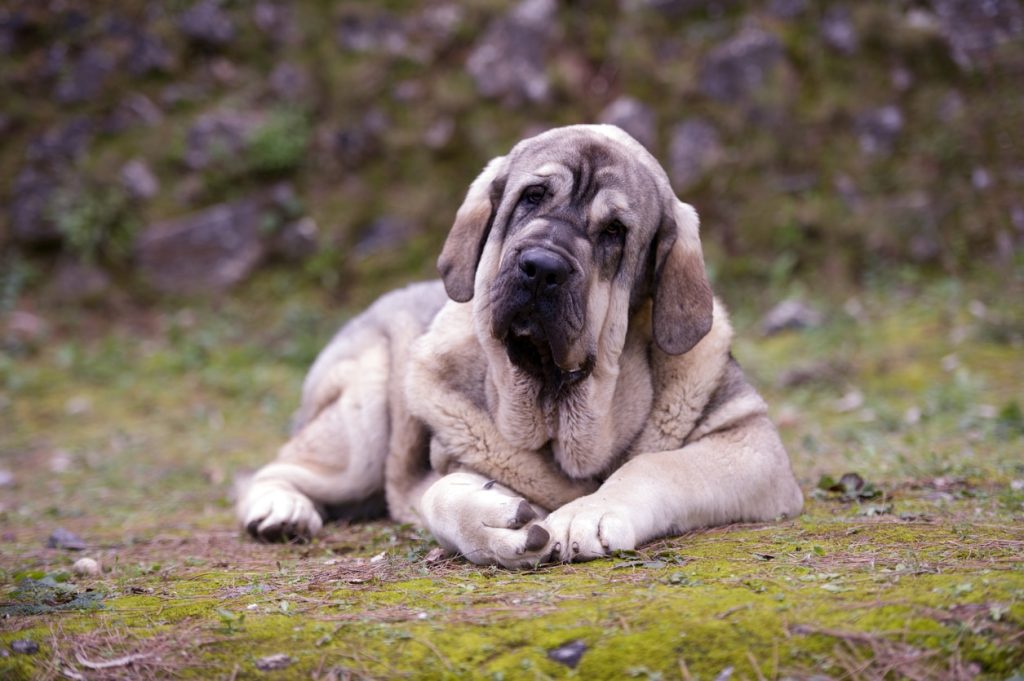
The Spanish Mastiff is a “difficult” breed, so don’t grab the first puppy you come across, especially at an attractive price. The choice of a new friend must be approached wisely. Fluffy babies must grow up to three months before they are attached to the family. At this age, the physical and mental health of animals is considered to be quite strong.
When meeting with Spanish mastiffs, you need to pay attention to the conditions of detention. The ideal option is a clean and draft-free aviary. Those who wish to purchase a puppy with an excellent pedigree can ask the breeder to provide all the necessary information, including information about the parents.
The appearance of the mastiff is no less important: strong bones, thick hair, healthy skin and mucous membranes, eyes and nose without pathological secretions. The kid should be playful and curious, not hide or run away from the outstretched hand. Moderate fatness is required: thinness is a sure sign that the puppy is unhealthy.
Rely on your intuition – it will tell you with which “Spaniard” the most reverent friendship will begin!
How much is the spanish mastiff
Those who want to acquire a fluffy friend of the Spanish Mastiff breed will have to fork out: the minimum price is 550 – 650$. Heirs with well-known “relatives” are five times more expensive: about 4500$. The best place to buy a Spanish Mastiff is a certified kennel. Animals from the bird market will not be able to boast of excellent genetics and excellent health.
Spanish Mastiff – Video



